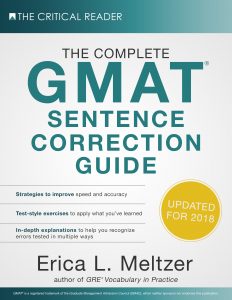If you look at many lists of GMAT® idioms, you’ll likely find dozens upon dozens of preposition-based constructions, e.g. insist on, characteristic of, correlate with. Although the GMAT does sometimes test these types of idioms, it is important to understand that they are not the primary focus of the test. Because of an increase in the number of international students taking the exam, the GMAC has elected to shift the focus away from idiomatic American usage and toward more issues involving overall sentence logic.
That said, there are still a handful of fixed constructions that the GMAT does regularly test. Many, but not all, of these fall into the category of word pairs (aka correlative conjunctions). Particularly if you are not a native English speaker, you are best served by focusing on these constructions, which stand a high chance of appearing, as opposed to memorizing dozens of preposition-based idioms that have only a minuscule chance of being tested on any given exam.
1) Fewer vs. Less
Fewer is used to describe things that are quantifiable (countable). It is always paired with singular nouns.
Less is used to describe things that are not quantifiable. It is always paired with plural nouns.
Note that the GMAT is more likely to use less to incorrectly modify singular nouns than it is to use fewer to modify plural nouns. The former construction is frequently used in everyday speech, so errors involving it are more difficult to identify by ear.
Incorrect: According to one recent study, people who exercise five or more times a week experience less respiratory infections than people who only exercise once a week or never at all.
Correct: According to one recent study, people who exercise five or more times a week experience fewer respiratory infections than people who only exercise once a week or never at all.
2) Due to
Due to = caused by.
If you encounter the phrase due to on a GMAT question, plug in caused by and see whether it still makes sense. If not, some variant of because or should probably be used instead. Note that due to is pretty much always incorrect. This phrase is very rarely used properly in everyday English, and so the GMAT tends to target its misuse rather than its use.
Incorrect: The long-tailed ground roller bird is placed in the ground roller family, which was given its name due to (caused by) its similarity to the rollers and its largely terrestrial nature.
Correct: The long-tailed ground roller bird is placed in the ground roller family, which was given its name because of (or: as a result of) its similarity to the rollers and its largely terrestrial nature.
3) The -ER, the -ER
This is a form of parallel construction used to indicate that an increase in one action causes an increase another action. Sentences involving it typically contain two clauses, with the comparative (more/-ER) placed at the beginning of each clause.
Correct: The higher housing prices climb, the greater the concern among economists that the market is headed for a crash.
4) More/-ER…Than
The comparative form of an adjective (adjective + -ER or more + adjective) must be paired with than.
Incorrect: Although many people have attempted to solve the mystery of Stonehenge, its purpose is hardly clearer in the twenty-first century as it was five hundred years ago.
Correct: Although many people have attempted to solve the mystery of Stonehenge, its purpose is hardly clearer in the twenty-first century than it was five hundred years ago.
5) Between…And
Incorrect: Certain parrot species can learn up to 2,000 words, in some cases further demonstrating their cognitive capacities through their ability to form associations between words to their meanings.
Correct: Certain parrot species can learn up to 2,000 words, in some cases further demonstrating their cognitive capacities through their ability to form associations between words and their meanings.
6) So/Such…That
Incorrect: While Einstein himself was so resistant to the idea of black holes and refusing to even acknowledge the possibility of their existence, other physicists used his groundwork to study these galactic giants.
Correct: While Einstein himself was so resistant to the idea of black holes that he refused to even acknowledge the possibility of their existence, other physicists used his groundwork to study these galactic giants.
7) Such as vs. Like
Such as = examples
Like = comparison
Such as is often incorrectly replaced by like before a set of examples. As a result, answers with such as tend to be correct.
Correct: People who seek out extreme sports like skydiving and mountain climbing often do so because they feel compelled to explore the limits of their endurance.
Correct: People who seek out extreme sports such as skydiving and mountain climbing often do so because they feel compelled to explore the limits of their endurance.
8) In contrast to
Incorrect: Contrasting with southern Renaissance painting, which focused on symmetry and perspective, northern Renaissance painting placed a greater emphasis on naturalism and surface detail.
Correct: In contrast to southern Renaissance painting, which focused on symmetry and perspective, northern Renaissance painting placed a greater emphasis on naturalism and surface detail.
When the formation of comparisons is tested, the GMAT also has a strong preference for (un)like.
Correct: Unlike southern Renaissance painting, which focused on symmetry and perspective, northern Renaissance painting placed a greater emphasis on naturalism and surface detail.
9) Regard as
Incorrect: Among historians, the fall of Constantinople in 1453 is generally regarded to be one of the most consequential events of the late Middle Ages.
Correct: Among historians, the fall of Constantinople in 1453 is generally regarded as one of the most consequential events of the late Middle Ages.
10) The term x refers to
A term can only refer to something; it cannot actually be something.
Incorrect: The term “Tudor myth” is a longstanding view of sixteenth-century England as a political and social golden age, ruled by the divinely-appointed Tudors.
Correct: Incorrect: The term “Tudor myth” refers to a longstanding view of sixteenth-century England as a political and social golden age, ruled by the divinely-appointed Tudors.


Thank you so much for this. I appreciate it!
Each one of the idioms is very useful and common in GMAT. It would awesome if you can share more like these.
Hi Erica! In your GMAT book, there’s a question that has “acknowledged to be” in a correct answer. “Acknowledged as” and “awknowledged as being” are in incorrect choices, but your solution only says that A, B, and C can be immediately eliminated because they say “any form” and not “any other form.” I was wondering what the correct idiom is for “acknowledged.” Does it follow the idiom for “considered”? Does it follow the idiom for “known”? Or does it have its own idiom? I had trouble finding “acknowledged” anywhere else in your guide. Thanks!
Hi Soph,
As far as I know, the “acknowledged” follows the same rule as “considered,” i.e., “acknowledged to be” is idiomatic, whereas “acknowledged as” is really iffy (and almost certainly wrong in GMAT land). I’ll try to stick something about that in the book the next time I make updates.
Erica